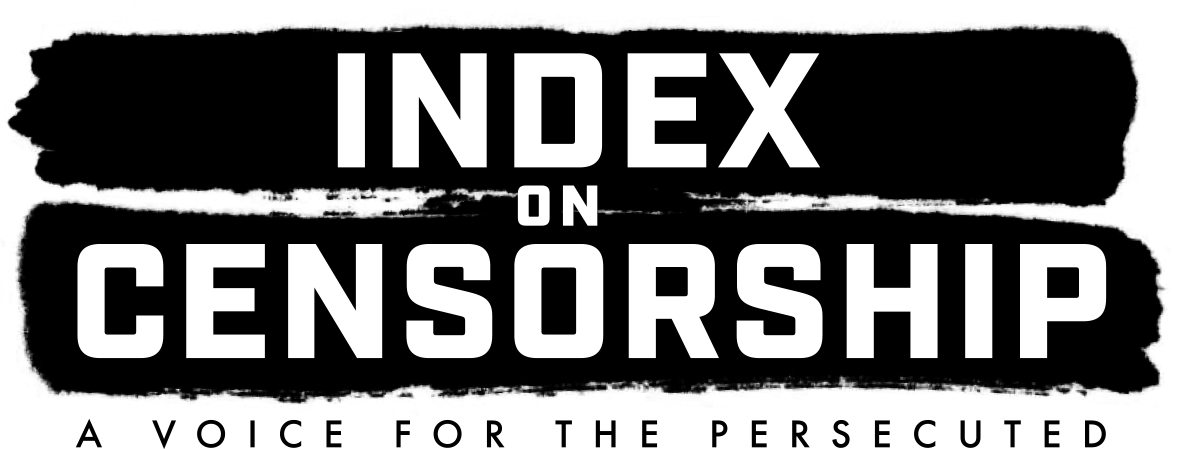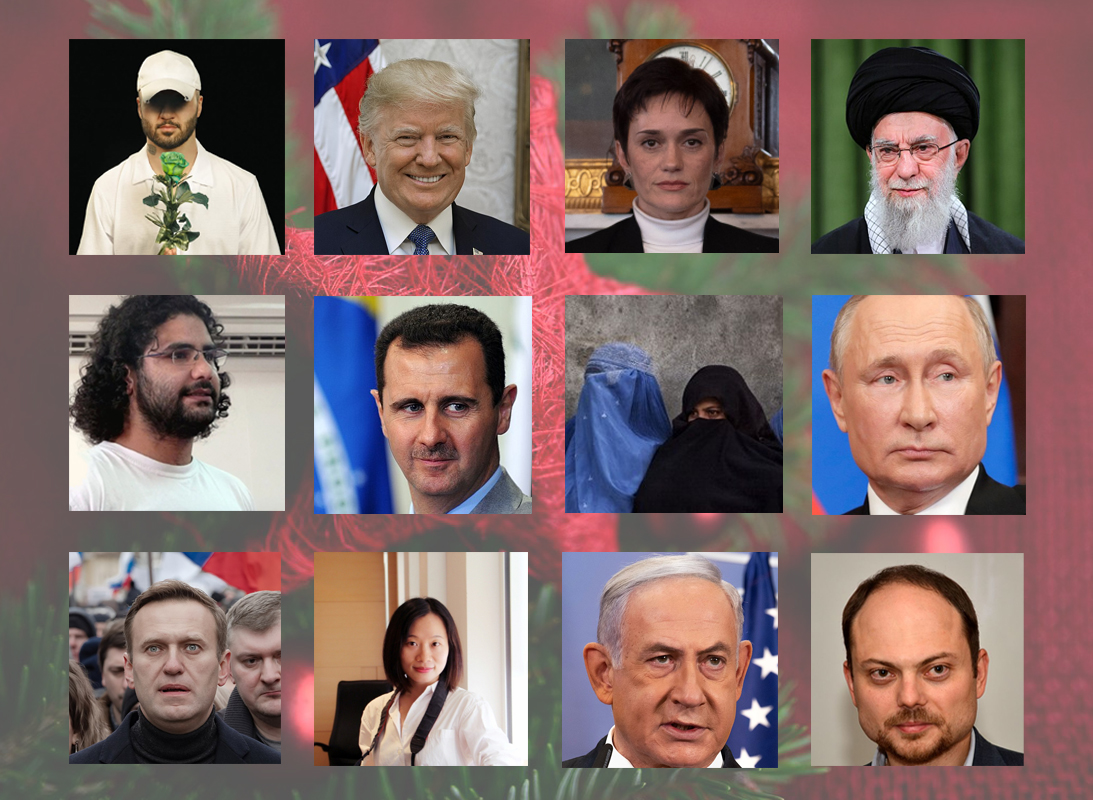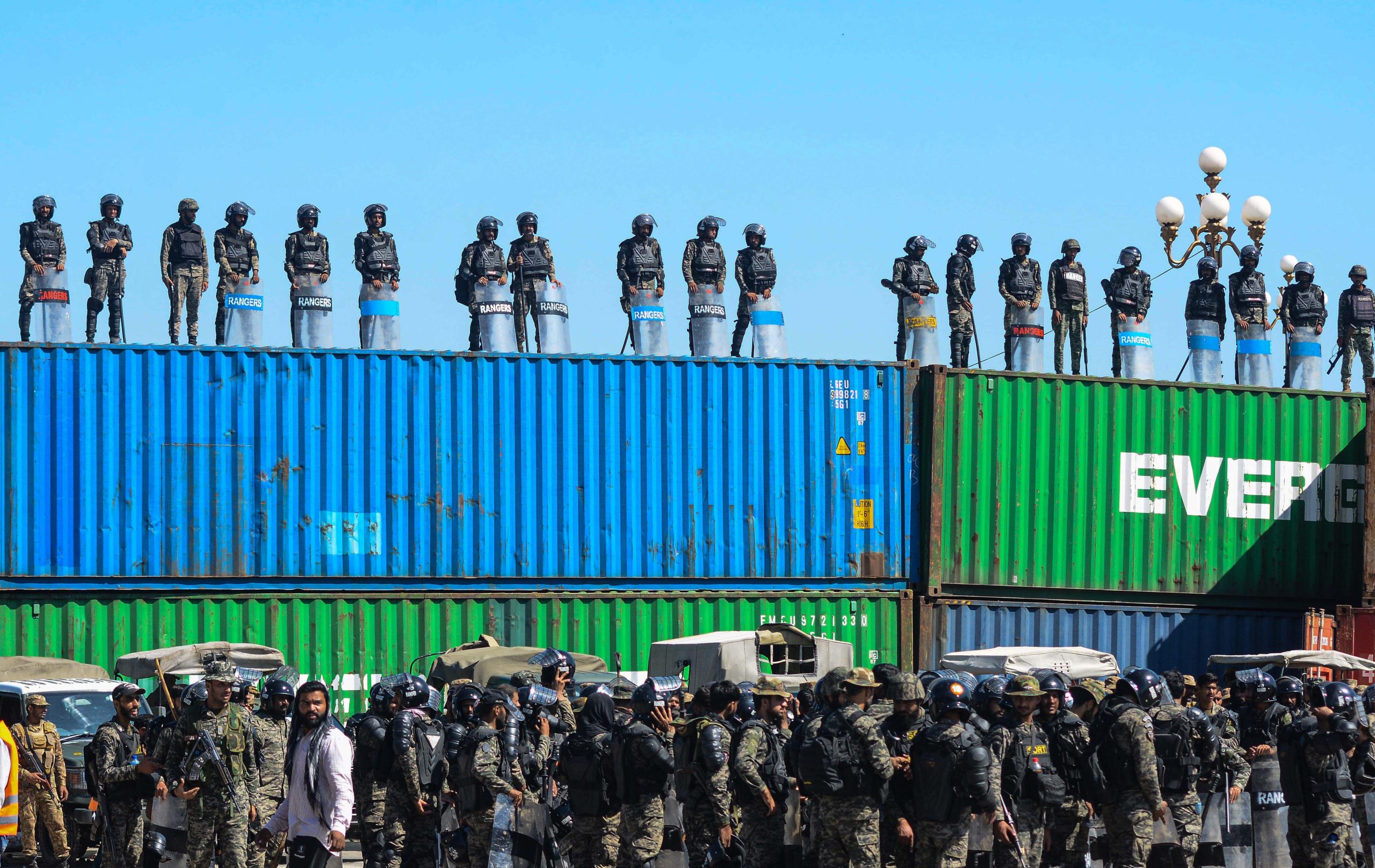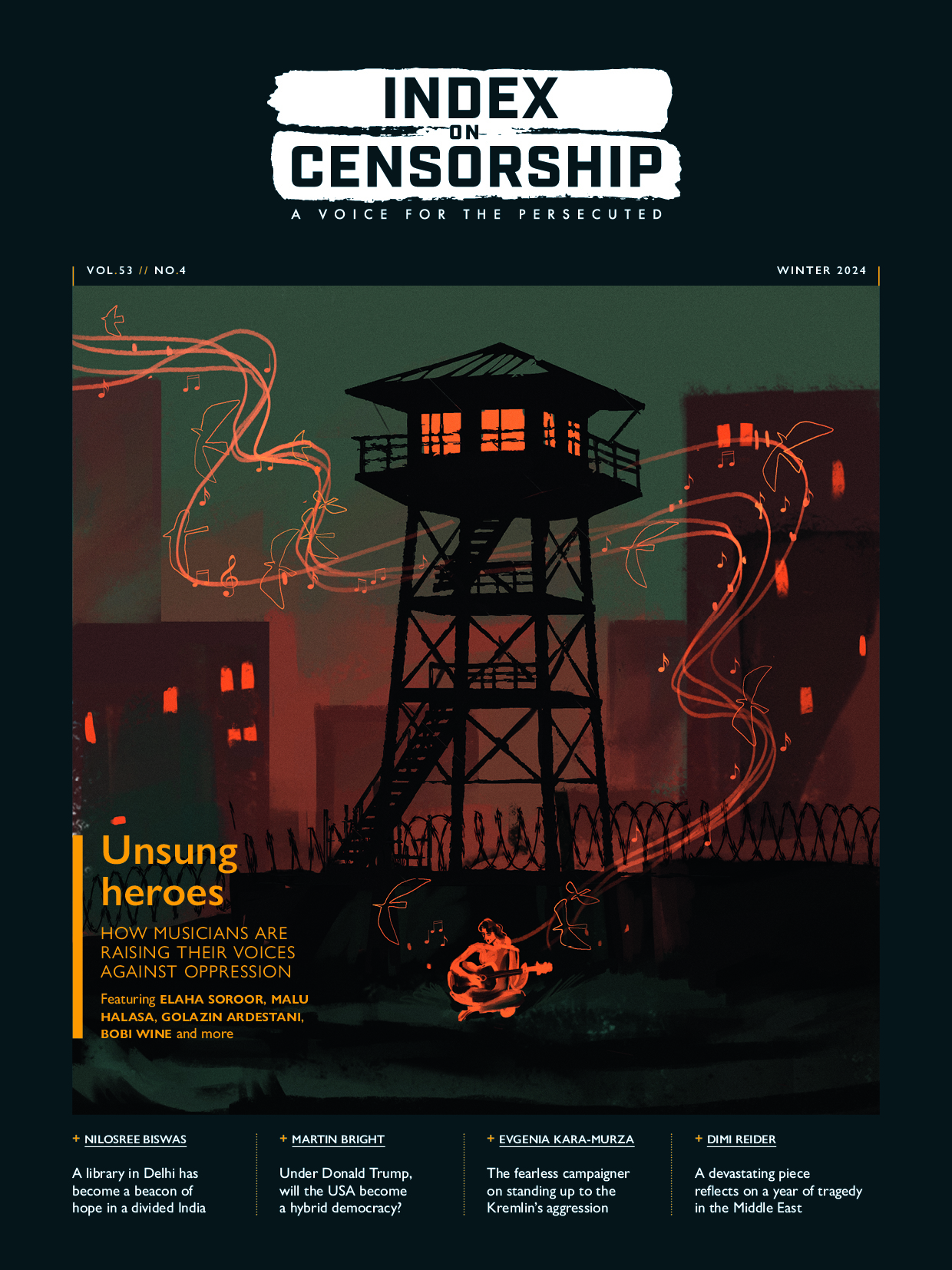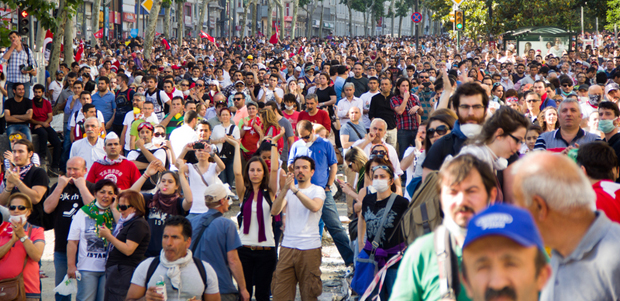
Thousands of protesters took to the streets of Istanbul on 1 June in the capital’s Taksim Square during demonstrations over plans to turn Gezi Park into a shopping mall. (Photo: Akin Aydinli / Demotix)
Author and playwright Meltem Arikan was amongst a small group of people who was accused by senior Turkish politicians and government sponsored media of being the architects of the May-June 2013 Gezi Park demonstrations. This was no idle threat, but a TV, newspaper and Twitter campaign designed to convince the Turkish people that the accused were responsible for the largest anti-government protest ever witnessed in Turkey. Forced to leave Turkey, she, and those closest to her, have come to live in UK and only now is she beginning to feel safe enough to tell her story.
What follows is Arikan’s personal account of the events.
For me everything starts on 27 May 2013.
Together with Memet Ali Alabora the director of my play Mi Minor, Pinar Ogun the lead actress and the play’s graphic designer Melin Edomwonyi, I went to KARVAK Awards Ceremony to receive our award for Best Play 2013 given by the Black Sea education, culture and environment protection foundation. As we made our way there, it didn’t seem possible that our lives were about to change completely. The ceremony started and the first award to be announced was a lifetime achievement award for the governor of Istanbul. The moment we heard this we stood up and left the venue, refusing to receive our award.
In Turkey, the governor is the highest state representative in the city, and has responsibility for and control over the police. At the time in Istanbul the frequent and excessive use of tear gas and heavy-handed police tactics to even the smallest gatherings — especially around Taksim — were causing real concern for us and many people. For example on 7 April, a peaceful demonstration of artists and cinema goers — including Greek film director Costa-Gavras — against the demolition of the Emek Theatre was dispersed with water cannons and tear gas.
We could not have accepted an award from an organisation that honoured the governor after all that was happening in the heart of our city.
We went straight home and read on Twitter that the trees at the Gezi Park, the only park in the area of the city called Taksim, were being destroyed to make way for a shopping mall. We started tweeting to make people aware of what was going on, that the trees needed protection. A small group of around 50 people went to the park to keep watch over the trees and stop them from being uprooted in the middle of the night. When the workmen drove into the park during the night ready to destroy the trees, the protesters asked if they had an official permit. They had no papers, so the workmen left the park. I followed everything on Twitter, retweeting the tweets and pictures that were coming out of the park. Looking at those pictures I was worried that, as with so many demonstrations, only a handful of people would turn up. So I kept retweeting moment by moment what was happening there all night.
Next Morning – 28 May
The digger came back in the morning at 8 am. By then there were 200 people in the park and, because of the growing numbers, the riot police used pepper spray and tear gas to clear it. At noon, pictures from Gezi Park were being shared on Twitter again, but this time they showed riot police using tear gas against peaceful protestors. The picture of the pepper-gassed woman in a red dress, that would later become an icon, was taken during this first police attack.
The attack had triggered more people to come to the park. We decided to join the protesters, to give our support to the trees and say “enough!” to the crazy number of shopping malls, which are poisoning our cities.
After the pepper gas attack the works in the park were restarted. This time the Istanbul MP, Sırrı Süreyya Önder, who is also a screenwriter and film director, stood with his arms wide open in front of a digger and asked for their permit. This stalled the destruction for the time being and the workmen left.
When we got to the park we could still smell the gas even though it was hours after the attack. Despite the stench, the joy and determination of the young protesters remained. By sunset nearly a thousand people had gathered. There were tents everywhere. It was clear that people living around Gezi Park supported the protests and they, too, wanted to save the trees, the treasured heart and lungs of Taksim Square. People were treating the damaged trees, and planting saplings in the holes left by the diggers. Women, men, strangers to one another, straight, gay, transsexual, young, old, little kids with their parents came together for the sake of the trees. Regardless of their differences they shared their feelings with one another. A table became a simple stage for people to speak from, prejudice gave way to the attempt to understand each other, music and dance took over from frustration. We wrote our thoughts on pieces of paper and hung them on the branches of the trees. Perhaps, in our country, where everyone had become “the other” to one another, for the first time, in that park, no one was “the other” anymore.
As the writer of the novel Hope is a Curse, it was wonderful for me to feel hope for the first time in years. Hope that, helped by new ways to exchange and share information, women and men can come together to lay claim to public space and freedom of speech, leaving the barriers of race, religion, sexual choices, language, ethnic roots and ideologies behind. Although we only planned to go to the park for an hour, after feeling the atmosphere there, I couldn’t leave. We all tweeted to spread the word that night. We chanted, danced, protested. It was as if something I had written years ago, was actually beginning to happen in front of me…
“Women!
We do not have to surrender to the beliefs that are imposed upon us.
The time has come for us to reclaim our stolen spirit.
We can sing the song of another culture without knowing its language.
Without knowing the steps, we can keep up with the rhythm.
The time has come for us to tune in to the music and the rhythm within ourselves.
Patriarchy will be scared, Patriarchy will resist. Patriarchy will accuse…
The time has come for us to reclaim our stolen spirit…
We will cover our ears and will burst out laughing at the accusations,
Women will dance and sing songs and laugh aloud.
In spite of everything, we will rise up in protest, propelled by our irrepressible laughter.
The new digital world will be shaped WITH women, not IN SPITE OF us”
29 May
The next day Prime Minister Recep Erdogan gave a speech and said that they will build a shopping mall no matter what the people say. After the prime minister’s speech more people came to Gezi Park.
I was there around 4 pm. This time there were thousands of people present, including supporter groups, political activists, environmentalists and even Turkish Airlines staff who were out on strike. People were coming to the park to give voice to the issues they were concerned about as well as to protect the trees.
It was like a festival. Even though it was much more crowded than the previous night, the atmosphere generated by such a large and diverse group of people was absolutely amazing. Could things change for real? This time, could we change things by singing songs, by dancing, by freely expressing ourselves all together? Could we actually protect this precious corner of nature from mad-made destruction? The leader of the opposition party visited the park that night. He promised to have two MPs stay there at all times. I left the park after midnight.
30 May
In the morning we heard that, at dawn around 5 am, the police had attacked people and the tents had been set on fire.
I was following everything on Twitter. Again, police had surrounded the park. Again, the Istanbul MP, Sırrı Süreyya, went to the park and again he stood up against the digger to stop the demolition. Again the police left the park. Once more, the protestors occupied the park. The tree watch went on.
Pinar and I didn’t get to the park until that night, because we had been in the studio all day shooting our TV programme Witch’s Cauldron. The early morning police raid had prompted crowds of people to come to the park. By the time we got there, there were more than 10,000 people gathered.
Some young people were tying pieces of colourful cloth to the branches of the trees to make wish trees just like in the old Shaman tradition. I was very moved to see young people picking up on this old tradition. More young trees were planted, more people were trying to heal the wounded trees. People were holding up banners and they were not just about Gezi Park. There were a lot of different issues addressed: protecting the environment, the demolition of the Emek Theatre, recent bombing and deaths in Antakya.
Speeches were made, poems were read and songs were sung on the small stage in the middle of the park. Yet again we chanted and danced until dawn.
31 May
We saw the riot police getting ready just as we were heading out of the square at 4 am. There were two MPs on duty from opposition party. We spoke to them. They said they could do nothing to stop the police attack.
As the sun rose, pressure in the park was rising. Protesters who were already awake warned those still sleeping in tents.
At 4:30 am, as we were on our way to a café down the road, the riot police moved in. At this point there were about 3,000 people in the park. Police used massive quantities of gas against the peaceful protestors. Trying to escape the storm of tear gas people got trapped on an old stone staircase in the park, which collapsed crushing dozens of protestors. Many people were badly affected by the excessive amount of gas, and many others were injured by tear gas capsules thrown directly at them.
It was, and still is, very difficult for me to tell the story of what happened that morning. Inside a café, on the first floor, even though the doors were shut, none of us was able to breathe without choking. I couldn’t make sense of the scene I was witnessing. What was this place? Where was I? What had happened to the songs, tents, banners and dances? The hope I had seen in the eyes of the young people, the wish notes on the trees, the voices of people united? What had triggered the violence? What had happened to turn all this into a war zone?
By 7 am Gezi Park was empty; everybody had fled. The police closed the park. Small numbers of people started to regroup in neighbourhoods around Taksim. We walked to Cihangir Street nearby. Sitting in a café it was hard to breathe and hard to believe how we had been abused. During the gas attack we had been separated from our friends, and now we were trying to get news about them. Had they been injured, arrested? Everyone was following the Twitter feeds, reading them out loud so that all of us could hear as reports coming out of Taksim Square told of the growing number of injured. The roads were closed, the police were everywhere and we were not able to leave the café. There was no media coverage of this brutality. Twitter was the only source of information and I was trying to follow every second of the feeds. I was furious and also felt completely disillusioned. A voice inside me was screaming “HOPE IS A CURSE! I TOLD YOU!”
At 10 am protesters who had now gathered outside Gezi Park made a statement to the press condemning the police brutality. After the press statement people tried to enter the park, and police once again fired tear gas. A couple of protestors, including the well-known journalist Ahmet Şık, were shot in the head with tear gas capsules. The police started to chase people in the streets but they were met with passive resistance – protesters stood still, some with their arms held up, some sitting on the ground. At 1 pm another statement was made — this time at Taksim Square. Then we heard that police once again had attacked.
We ran to help, but people had already dispersed. On the way back police were firing tear gas everywhere. A gas capsule fell next to my feet, I felt like I would never be able to breathe again. We washed our faces immediately with a mixture of water and Rennie tablets to neutralise the burning of the gas, and hid in an apartment building. I tried to come to grips with the reality of what was happening in front of my burning eyes. I could hear the sirens from outside and the screams of the people running. The same words going around in my head: Why all this violence and brutality? Why this hatred – who was it for? Once again I was witnessing how brutal male domination can be when people come together and say NO!
A young woman was hit by a capsule on her head, which left her in a coma for 30 days. She is still fighting for her life.
That day “Taksim Dayanışması” (Taksim Solidarity) the platform of nearly a hundred NGOs, political parties, and trade unions, that started the campaign against the planned shopping mall in Gezi Park called people to come together at Gezi Park at 7 pm. That day millions of tweets called for a gathering at Gezi Park.
All the time that Taksim was in chaos, there was nothing about what was happening in the mainstream media. Even more absurdly, one of the main news channels was showing a documentary about penguins while thousands of people were being attacked in the centre of Istanbul. This inspired a wave of satirical graffiti around the city – penguins in gas masks with slogans of defiance. We couldn’t go home because all the roads were closed and every minute more and more people appeared on the streets with goggles, helmets and plastic bottles filled with Rennie and water to protect each other from the effects of the gas.
Hearing the sounds of helicopters mixing with the sirens of the ambulances I felt completely disorientated. I closed my eyes and opened them… People falling on the ground in pain barely visible through the gas… I closed my eyes and opened them again to look for the helicopters I could only hear… I closed my eyes and opened them… A street dog lying on the ground… I closed my eyes and tears flowed in to my mouth tasting of pepper. My lips formed the word ENOUGH!
“I have seen how violence was created, when Patriarchy became merciless.
It was so cruel that I was frightened…
When the lives of those given by women were slaughtered by Patriarchy …
I saw nothingness…
The lives of those given by women were turning into fear and violence…
When we silently screamed ‘enough’, the cruelty of violence is so dense…
Enough, I feel shame.
Enough, I am a woman, violence was not born of me…”
On the night of 31st of May hundreds of thousands of people tried to reach Taksim Square on foot. We spent an hour on the street and then went to our friend’s home nearby. We could smell the gas inside the house and hear the ambulances, helicopters and people banging pots and pans in support of the protests from the windows of their houses. Then the first clashes between police and the protestors started; they carried on all night. We didn’t sleep at all.
1 June
In the morning Taksim was like a battlefield. The square was still surrounded by the police, and the protestors were still in the streets. Any one attempting to enter the square was forced back by the police.
Around 5:20 am, thousands of people started to march from the Asian side of Istanbul and crossed the Bosporus Bridge on foot to reach Taksim. They were joined by a big rally which had been planned months before to take place on 1 June on the Asian side. The government gave them permission and the police blockade was lifted. Hundreds of thousands of people entered Taksim Square. It was peaceful there but we heard about outbreaks of violence elsewhere because protests had spread to many parts of Istanbul and all around Turkey.
A group of high-profile artists, actors, directors, writers came together to appeal directly to the governor to stop the excessive use of police force, which they felt was responsible for the escalating violence. They couldn’t contact him so they sent out a call to fellow artists to join them in Cihangir Park to make a filmed appeal from the demonstration. I was there, too. When we entered the square there were nearly a million people and it was almost impossible to move through the crowds. Memet Ali Alabora, president of the actors union, spoke for the artists, addressing the governor and calling for peace; his speech was filmed and broadcast live as part of the first TV coverage of the demonstration.
Soon after the statement was made, I managed to get back to my house. I had no idea that I was to become a prisoner in my own home. From that moment until the day, two months later, when I decided to leave the country for good, I would only go outside once, for an hour, to the local shops.
At night clashes between police and protestors became increasingly brutal. That was when everything started to be broadcast internationally.
After the broadcasts went out all around the world the government, in an attempt to explain away what was happening, claimed that it was a conspiracy, a plot sponsored by foreign countries designed to bring us down. The only way the government could make sense of it was to find to someone to blame it on and to punish those responsible.
4 June
As the police violence increased more and more people left their houses and went out onto the streets. The more police brutality there was, the more people gathered in solidarity. The more thuggish the behavior of the police the more protestors responded with humour and satire – graffiti started to appear on the walls.
During the demonstrations the government had tried to control the flow of information, but they had failed to understand the significance of social media. They learned a valuable lesson — censoring the media had not prevented the people from finding out what was going on. In fact it had the opposite effect. It spawned thousands of new social media users, who understood — some for the first time — what young people have known all their lives, that new media has transformed the way we share and access information and ideas.
This change in perception was more threatening to the authorities than any weapon and signals the transition from the analogue to digital world order. In Gezi Park there was no leader, everything started and developed spontaneously. The majority of the protesters were from the new digital generation, who connect with the world, using technological tools to access the free flow of information and to express themselves freely.
As the Turkish prime minister said: Twitter has become a troublemaker.
Instead of listening to us — to the citizens — the prime minister, like an authoritarian father, tried to silence us, gave orders to the police to attack and harm us — seven young people and a police officer died, 4,329 people were injured some lost their eyes, others their arms, a few still in hospital — all because of the excessive police violence.
Instead of trying to understand what we were feeling, he told us he didn’t care. For thousands of years patriarchy has perpetrated violence by ignoring its conscience. Our prime minister said Obey Me. Arrogant, ignorant, oppressive, persistent and irreconcilable as always. Here were the age-old violent tactics of male domination used against men and women whose crime was to come together to protect nature from needless destruction.
The world thinks Turkey is a third world country, but in Gezi Park the demonstrators supported modern secular universal values. They didn’t say we are hungry or we want a job. Instead they said, “We respect nature and defend the lives of the trees. We want to exist as who we are, we want religious, sexual and cultural freedom. We don’t want racial, ethnic or political discrimination. We want free flow of information, we want free expression.”
Read Index’s interview with Arikan: A conversation with Meltem Arikan, Turkish playwright and author (7 January 2014)
This article was posted on 22 January 2014 at indexoncensorship.org
